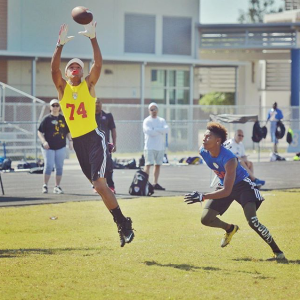
Wide receivers are the playmakers on the field. They make the acrobatic catches, run for 40+ yards after a catch and dance effortlessly in the end zone. They must have a good combination of physical traits and hand-eye coordination. A great receiver is such a complicated combination of traits—agility, body control, strength, quickness, soft hands, physical stamina, concentration, focus, toughness, pride, eye–hand coordination, vision and intelligence. (Norvell)
Sounds simple but a wide receiver must know how to catch the ball. If a receiver cannot catch the ball consistently, he will not be a threat on the field. When the running game is heavily defended, the quarterback will look to throw to his receiver. For practice, young athletes should try catching the ball with no gloves. This will make catching the ball easier once gloves are added in the equation. A receivers hands should not cover their face nor should the ball hit his chest before he makes the catch.
Catching the ball is only half of the battle. Great receivers can catch on the run or make a play on a ball not thrown in his direction. Wideouts must have quick feet and run good routes. Whether a receiver is cutting through the middle or tiptoeing against the sidelines, a lot of the work is done from the hips down. Good receivers must be able to shake a defender away from him during tight coverage. A receiver’s agility and speed determine whether they can keep space between him and his defender.
Wide receivers with excellent footwork will help them catch the ball better. It is ideal for the receiver to reach the end of his route at the same time the ball is hitting his hands. A combination of quarterback accuracy and the speed and good hands of the receiver will almost always guarantee a catch. The quarterback and receiver must be on the same page. Receivers are quick minded and have the ability to adjust with the moving parts of the game.
Speed is equally as important as having good vision. In order to beat the one on one competition, wide receivers must be able to see what is happening on the field as the play happens. If the receiver does not know what once the ball is snapped, he will have a hard time locating the ball once it is thrown. Every route in the playbook has a certain depth and spacing on the field. The receiver’s job is to run the route at the proper depth and get open at the proper time. Without good vision, he will not know where to go.
Space is important for a receiver because it makes it easier to catch the ball. He must use his speed and ability to change direction in order to create space. When there is not enough space between a defender and the wideout, the wideout will be more likely to use his arms to push off and create space which will result in an offensive pass interference.
There will be times where a receiver is called to block on a play and make room for the running back or a quarterback keeper. Upper body strength for a wide receiver is just as important as below the abdomen. A wide receiver who is 5’10”, 165 pounds may have a harder time blocking a cornerback or defensive back than a player who is 6’3”, 195 pounds. Good blocking is an overlooked trait for many receivers. Strength helps players get off the line when the defensive back tries to jam them. Strength helps when two players are fighting for position as they run down the field and work for position on the ball. Strength also helps when going up for high balls and jump balls.
All of these traits will help receivers withstand one on one competition. With great speed, agility, ability to quickly change direction and vision, receivers could shake any corner back on defensive back on their tail. The best NFL wide receivers know how to change direction without affecting the outcome of the catch or where the quarterback throws the ball. With all of these traits combined, the most important thing for a wide receiver to do is get open.
To learn more elite techniques the pros use, apply to a Football University camp today to train with our NFL Coaches by clicking the button below.

